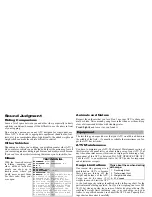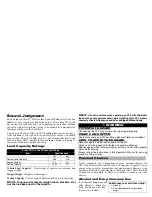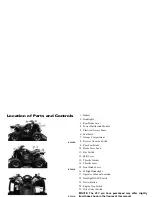
16
!
WARNING
Indicates a hazardous situation which, if not avoided, could result in death or serious injury.
Prevention
Gloves
Your hands are targets for flying objects and branches. Along with
providing skin protection, gloves will shield your hands from harsh
weather. Wear gloves that are weather resistant and have a gripping
surface to keep them from sliding off the handlebar. Off-road style
gloves with knuckle pads are the best for comfort and protection.
Boots/Ankle Protection
Wear a boot that covers the largest possible area of your leg (prefera-
bly up to your knee) and can handle significant impact. Choosing
boots with low heels and a good tread will help prevent your feet from
slipping off the footrests in wet or rugged conditions or getting hurt if
they get hit by rocks, dirt, or branches.
Eye Protection
Wear eye protection, such as goggles, to completely surround your
eyes to prevent getting dirt or other items in your eyes. Do not depend
on sunglasses for proper eye protection. Sunglasses are not recom-
mended; they don’t prevent objects from flying in through the sides.
Long Pants and Long Sleeved Shirt
The goal is to protect your body from branches, long grass, airborne
objects, or anything else that could scrape your skin. The more thick and
durable the material, the better protection it’ll provide. Riding pants with
kneepads, a jersey, and shoulder pads provide the best protection.
The second step in Prevention is checking the condition of your ATV.
Chances are good that you’ll be using your ATV in some rough terrain, and
there’s no way you want your brakes to go out when riding downhill. You
need to check the following parts on your ATV before every ride.
1. Tires and Wheels
2. Controls and Cables
3. Lights and Electric
4. Oil and Fuel
5. Chassis
6. Miscellaneous Items
One easy way to remember what parts you need to check is by using
the acronym “T-CLOC.” It stands for:
1. TIRES AND WHEELS
Correct tire pressure is crucial.
Consult the Specifications sec-
tion of this Operator’s Manual
for tire pressure guidelines.
Incorrect tire pressure can cause poor handling, instability, and a loss of
ATV control.
While checking the tire pressure, inspect the tread and sidewalls of the
tires for cracks, cuts, or other damage that could indicate they need to
be replaced.
2. CONTROLS AND
CABLES
With the engine running and brake
applied, check all transmission posi-
tions: forward, neutral, and reverse.
ATV Condition
T
C
L
O
C
T
IRES
AND WHEELS
C
ONTROLS
AND CABLES
L
IGHTS AND
ELECTRIC
O
IL AND
FUEL
C
HASSIS
Check:
1. Tire pressure
2. Tire surface (tread and sidewalls)
Check:
1. Forward
2. Neutral
3. Reverse
Summary of Contents for 2014 XC 450
Page 71: ...Maintenance Record DATE MILEAGE SERVICE PERFORMED NOTES ...
Page 72: ...NOTES ...
Page 73: ...NOTES ...
















































